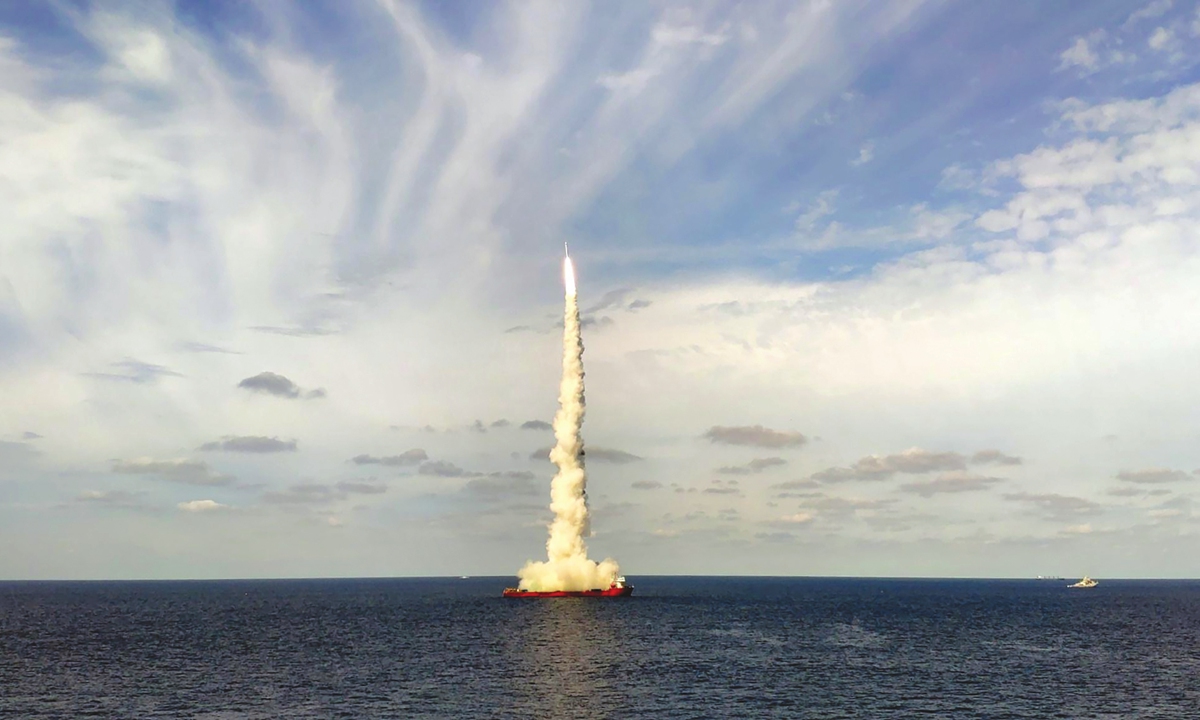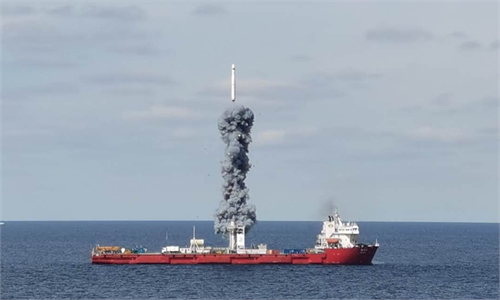
A Long March-11 solid-propellant light launch vehicle lifts off from a mobile floating platform in the Yellow Sea off the coast of East China's Shandong Province on Tuesday. Photo: VCG
China's first vessel to support satellite launches from the sea in particular is expected to be delivered by 2022, following a recent ceremony to mark the start of the ship's construction in the city of Haiyang, East China's Shandong Province.
The New-Type Rocket Launch Vessel will be 162.5 meters long with a 40-meter-width, and it is designed to meet the increasing demand for the launch and recovery of China's existing medium- to large-sized solid-propellant rockets and those under development, as well as small- to medium-sized liquid-propellant ones, the Global Times learned from project insiders on Sunday.
The construction of the new vessel will be a major step toward such a goal, and insiders said that the new vessel will further hone the country's high-frequency sea launch capability and lay a solid technological foundation for China's future rocket recoveries at sea.
Dubbed China's fifth space launch center, the construction of the China Oriental Spaceport as a base for sea launches of light-lift solid rockets was approved in July 2019.
Rocket manufacturer China Rocket Co, which is affiliated with the country's largest rocket developer and maker - the China Academy of Launch Vehicle Technology - and the city government of Haiyang signed a contract, pledging to build a 163-hectare production base for solid-propellant rockets in December 2020.
The base is part of a comprehensive aerospace project. With an investment of 23 billion yuan ($3.5 billion) and planned area of 1,860 hectares, the project includes an aerospace industrial park, a port for seaborne rocket launches and an aerospace-themed tourist park.
Apart from seaborne rocket launches, the base will offer services such as rocket assembly and testing. The Haiyang base will be able to produce 20 solid rockets each year, the company previously said.
So far, China has conducted two successful seaborne launches.
The first sea-based launch was carried out in June 2019, also using a Long March-11 carrier rocket, on a large semi-submersible barge named Tairui in the Yellow Sea, which marked a breakthrough in the safety, stability and reliability of launches at sea despite complicated marine environments.
The second seaborne launch took place in September 2020, also using the Long March-11.
The new spaceport in Haiyang has played a key role in the second mission, with assembly of the rocket for the sea launch mission and the rocket-satellite installation both carried out at the China Oriental Spaceport. The rocket was then transferred from Haiyang port to its designated launch site using a specially converted barge named Debo 3.
Compared with traditional inland bases, the Haiyang site will streamline the general assembly and pre-launch testing work, and save time spent on rocket de-assembly and transfer, experts said.
The base will help improve China's sea-launch efficiency by 10-15 days, while providing better risk management, Li Shaoning, a deputy chief engineer with the project developer - rocket producer China Rocket Co - told the Global Times at the time of the second seaborne launch in 2019.
The Smart Dragon-3 solid-fuel launch vehicle, which can send up to 20 satellites in one go, has gained project approval and is expected to make its maiden flight in 2022, the Global Times previously reported. Smart Dragon-3 will be also available for sea launch missions, Li said.


